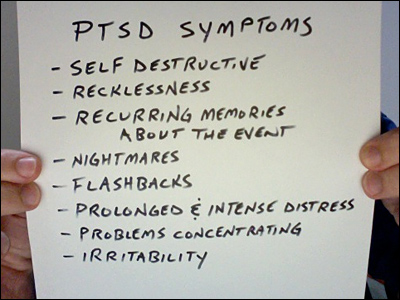

Trauma-related external reminders (e.g., people, places, conversations, activities, objects, or situations).Ĭriterion D: negative alterations in cognitions and mood.Persistent effortful avoidance of distressing trauma-related stimuli after the event: (1 required) Marked physiologic reactivity after exposure to trauma-related stimuli.Intense or prolonged distress after exposure to traumatic reminders.Note: Children may re-enact the event in play. Dissociative reactions (e.g., flashbacks) which may occur on a continuum from brief episodes to complete loss of consciousness.Note: Children may have frightening dreams without content related to the trauma(s). Note: Children older than 6 may express this symptom in repetitive play. Recurrent, involuntary, and intrusive memories.The traumatic event is persistently re-experienced in the following way(s): (1 required) This does not include indirect non-professional exposure through electronic media, television, movies, or pictures.
Dsm 5 ptsd criteria professional#
Repeated or extreme indirect exposure to aversive details of the event(s), usually in the course of professional duties (e.g., first responders, collecting body parts professionals repeatedly exposed to details of child abuse).If the event involved actual or threatened death, it must have been violent or accidental Indirectly, by learning that a close relative or close friend was exposed to trauma.The person was exposed to: death, threatened death, actual or threatened serious injury, or actual or threatened sexual violence, as follows: (1 required)
Dsm 5 ptsd criteria full#
In both specifications, the full diagnostic criteria for PTSD must be met for application to be warranted. Two specifications are noted including delayed expression and a dissociative subtype of PTSD, the latter of which is new to DSM-5. The sixth criterion concerns duration of symptoms the seventh assesses functioning and, the eighth criterion clarifies symptoms as not attributable to a substance or co-occurring medical condition. The criteria below are specific to adults, adolescents, and children older than 6 years.ĭiagnostic criteria for PTSD include a history of exposure to a traumatic event that meets specific stipulations and symptoms from each of four symptom clusters: intrusion, avoidance, negative alterations in cognitions and mood, and alterations in arousal and reactivity.

Note that DSM-5 introduced a preschool subtype of PTSD for children ages 6 years and younger. The diagnostic criteria are specified below.
Dsm 5 ptsd criteria manual#
In 2013, the American Psychiatric Association revised the PTSD diagnostic criteria in the fifth edition of its Diagnostic and Statistical Manual of Mental Disorders (DSM-5) (1). The information below will hopefully be useful in helping you to better understand how this diagnosis is used in practice. Assessment of PTSD involves carefully considering the nature of the event itself and the effects this has had on different aspects of our life.


 0 kommentar(er)
0 kommentar(er)
